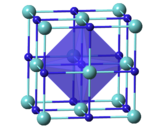Zirconium nitride

| |
| Names | |
|---|---|
| IUPAC name
Zirconium nitride
| |
| Other names
Zirconium(III) nitride, Nitridozirconium
| |
| Identifiers | |
3D model (JSmol)
|
|
| ChemSpider | |
| ECHA InfoCard | 100.042.864 |
| EC Number |
|
PubChem CID
|
|
CompTox Dashboard (EPA)
|
|
| |
| |
| Properties | |
| ZrN[1] | |
| Appearance | Yellow-brown crystals |
| Odor | Odorless |
| Density | 7.09 g/cm3 (24 °C)[1] |
| Melting point | 2,952 °C (5,346 °F; 3,225 K) at 760 mmHg[1] |
| Insoluble | |
| Solubility | Soluble in concentrated HF, acids[1] |
| Structure | |
| Cubic, cF8[2] | |
| Fm3m, No. 225[2] | |
a = 4.5675 Å[2] α = 90°, β = 90°, γ = 90°
| |
| Octahedral[2] | |
| Thermochemistry | |
Heat capacity (C)
|
40.442 J/mol·K[3] |
Std molar
entropy (S⦵298) |
38.83 J/mol·K[3] |
Std enthalpy of
formation (ΔfH⦵298) |
−365.26 kJ/mol[3] |
| Related compounds | |
Related refractory ceramic materials
|
Tantalum carbide Niobium carbide Zirconium carbide |
Except where otherwise noted, data are given for materials in their standard state (at 25 °C [77 °F], 100 kPa).
| |
Zirconium nitride (Template:ZirconiumTemplate:Nitrogen) is an inorganic compound used in a variety of ways due to its properties.
Properties
ZrN grown by physical vapor deposition (PVD) is a light gold color similar to elemental gold. ZrN has a room-temperature electrical resistivity of 12.0 µΩ·cm, a temperature coefficient of resistivity of 5.6·10−8 Ω·cm/K, a superconducting transition temperature of 10.4 K, and a relaxed lattice parameter of 0.4575 nm. The hardness of single-crystal ZrN is 22.7±1.7 GPa and elastic modulus is 450 GPa.[4]
Uses

Zirconium nitride is a hard ceramic material similar to titanium nitride and is a cement-like refractory material. Thus it is used in refractories, cermets and laboratory crucibles. When applied using the physical vapor deposition coating process it is commonly used for coating medical devices,[5] industrial parts (notably drill bits), automotive and aerospace components and other parts subject to high wear and corrosive environments.
Also zirconium nitride was suggested as a hydrogen peroxide fuel tank liner for rockets and aircraft.[6]
References
- ^ a b c d Lide, David R., ed. (2009). CRC Handbook of Chemistry and Physics (90th ed.). Boca Raton, Florida: CRC Press. ISBN 978-1-4200-9084-0.
- ^ a b c d Sirajuddeen, M. Md. Sheik.; Banu, I. B. S. (2014). "FP-LAPW investigation of electronic, magnetic, elastic and thermal properties of Fe-doped zirconium nitride". AIP Advances. 4 (5): 057121. doi:10.1063/1.4879798.
- ^ a b c Zirconium nitride in Linstrom, Peter J.; Mallard, William G. (eds.); NIST Chemistry WebBook, NIST Standard Reference Database Number 69, National Institute of Standards and Technology, Gaithersburg (MD) (retrieved 2014-06-30)
- ^ Mei, A. B.; Howe, B. M.; Zhang, C.; Sardela, M.; Eckstein, J. N.; Hultman, L.; Rockett, A.; Petrov, I.; Greene, J. E. (2013). "Physical properties of epitaxial ZrN/MgO(001) layers grown by reactive magnetron sputtering". Journal of Vacuum Science & Technology A: Vacuum, Surfaces, and Films. 31 (6): 061516. doi:10.1116/1.4825349.
- ^ "IonFusion Surgical". IonFusion Surgical, Inc. Retrieved 2014-06-30.
- ^ 7736751
